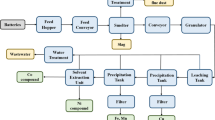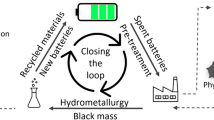Abstract
To reveal the historic characteristics of the material flow, energy flow and value flow in a lead-acid battery (LAB) system, a framework for the coupling relationship among the three flows was established based on material flow analysis and the characteristics of the energy and value flows. The coupling coefficients between energy and material (CCEM) and value and material (CCVM) were also defined. The investigation used by China as a case to study changes in stages and the historic evolution. The results show that the CCEM for lead in LABs was highest in the usage stage, approximately 5–16 times greater than in the other stages. The CCEM for production was almost twice as high for primary lead as for secondary lead, and the CCEM was lowest for the fabrication and product manufacture stage. The CCVM for lead in LABs was 2.5–6 times higher than for other types of lead. The CCVM was lower for scrap lead than for lead ore, and the CCVM was approximately 1.7 times higher for refined lead than for scrap and refined lead. For lead trade, CCVM was correlated with domestic and overseas markets. From 1990 to 2014, the CCEM for each stage was in decline, whereas the opposite was the case for CCVM. The influencing factors were analyzed in terms of resources, the environment, and markets. Increasing the circulation rate of scrap lead is an effective way to rapidly save resources, reduce lead pollution, and promote a circular economy. The limitations and potential value of the study are also highlighted, and future research is outlined.





Similar content being viewed by others
References
Bai L, Qiao Q, Li YP et al (2015) Substance flow analysis of production process: a case study of a lead smelting process. J Clean Prod 104:502–512
Bai B-Y, Hu X-W, Li Y-P et al (2016) Present situation, problems and countermeasures of the secondary lead industry in China. Environ Eng 05(34):126–130 (in Chinese)
Bai L, **e MH, Zhang Y et al (2017) Pollution prevention and control measures for the bottom blowing furnace of a lead-smelting process, based on a mathematical model and simulation. J Clean Prod 159:432–445
Bates A, Mukerjee S, Lee SC et al (2014) An analysis study of a lead-acid battery as an energy storage system. J Power Sources 249:207–218
Cai JJ, Wang JJ, Lu ZW et al (2006) Material flow and energy flow in iron & steel Industry and correlation between them. J Northeastern Univ 27(9):979–982 (in Chinese)
Cai JJ, Ye Z, Sun WQ (2013) Analysis of influence factor on energy consumption in Chinese steel industry from 1995 to 2010. J Northeastern Univ 34(10):1438–1442 (in Chinese)
Chen Z-X, Zhang Y-J, Song Y-L et al (2016) The analysis of current situation and development trend of secondary lead. Chinese LABAT Man 53(02):96–100 (in Chinese)
China Automotive Technology & Research Centre (CATRC), China Association of Automobile Manufactures (CAAM) et al (1999-2011) China automotive industry yearbook 1999-2011. China Association of Automobile Manufactures Press, Bei**g
China Battery Industry Association (CBIA) (2010) China battery industry yearbook 2010. China Statistics Press, Bei**g
China Nonferrous Metals Industry Association (CNMIA) (1995-2015) The yearbook of nonferrous metals industry of China (1991–2015), China Nonferrous Metals Industry Yearbook Press, Bei**g.(in Chinese)
Dai T, Wen B-J, Liang J (2017) A tentative discussion on the law of lead consumption and a prediction of China’s lead demand. Acta Geosci Sin 38(1):61–68 (in Chinese)
Du T, Cai J-J (2006) Study on material, energy, pollutant flows for iron and steel enterprise. Iron Steel 41(4):82–87 (in Chinese)
Feng C-J (1997) Lead market review in 1996 and prospect in 1997. World Nonferrous Metals 3:17–19 (in Chinese)
Feng C-J (1999) Review of lead and zinc market at domestic and abroad and recent trend analysis. World Nonferrous Metals 8:29–35 (in Chinese)
Gu J-N, Zhang X-Y, Han J-X (2017) Global lead resources situation and the development of lead resources in China. China Min Mag 26(2):16–20 (in Chinese)
He HC, Guan HJ, Zhu X et al (2017) Assessment on the energy and carbon emissions of intergrated steelmaking plants. Energy Reports 3:29–36
International Lead and Zinc Study Group (ILZSG) (2013, 2014) Review and outlook for Cooper, Nickel, Lead and Zinc, London. http://www.ilzsg.org/static/statistics.aspx?from=1
Kamila B, Zdenka W, Jaroslav D, Magdaléna Z (2015) The material flows of lead in the Czech Republic. Resour Conserv Recycl 9:1–8
Liang J, Mao JS (2014) A historical analysis of environmental losses from anthropogenic lead flow and their accumulation in China. Trans Nonferrous Metals Soc China 24(4):1125–1133
Liang J, Mao JS (2015) Source analysis of global anthropogenic lead emissions: their quantities and species. Environ Sci Pol R22:7129–7138
Liang J, Mao JS (2016) Risk assessment of lead emissions from anthropogenic cycle. Trans Nonferrous Metals Soc China 16:248–255
Liu Y-J (2009) Dynamic changes in energy efficiency and energy prices. J Yangzhou Univ 13(4):94–101 (in Chinese)
Liu LR, Lu ZW, Yu QB et al (2002) Analysis of comprehensive energy consumption for producing alumina. Chinese J Nonferrous Metals 12(6):1294–1298 (in Chinese)
Liu W, Sang J, Chen LJ et al (2015) Life cycle assessment of lead-acid batteries used in electric bicycles in China. J Clean Prod 108:1149–1156
Liu P, Li BK, Cheung Sherman CP, Wu WY (2016a) Material and energy flows in rotary kiln-electric furnace smelting of ferronickel alloy with energy saving. Applied Therm Eng 109:542–559
Liu W, Chen LJ, Tian JP (2016b) Uncovering the evolution of Lead in-use stocks in Lead-acid batteries and the impact on future lead metabolism in China. Environ Sci Technol 50:5412–5419
Liu W, Tian JP, Chen LJ et al (2017) Historical and spatial characteristics of lead emissions from the lead-acid battery manufacturing industry in China. Environ Pollut 220:696–703
Ma Z-H, Fan Z-L (2011) Domestic lead resources and related suggestions. China Metal Bulletin 33:22–21 (in Chinese)
Ma L, Mao J-S (2014a) Quantitative analysis on the changes in anthropogenic lead flow of China. Environ Sci 35(7):2829–2833 (in Chinese)
Ma L, Mao J-S (2014b) The reasons for the changes in anthropogenic lead flow of China. Environ Sci 35(8):3210–3224 (in Chinese)
Mao JS (2016) Anthropogenic flow of lead. Science Press, Bei**g
Mao J-S, Lu Z-W (2003) The material circular flow and value circular flow. J Mater Metall 2(2):157–160 (in Chinese)
Mao J-S, Lu Z-W (2006) The lead flow analysis for lead-acid battery system. Environ Sci 27(3):43–48 (in Chinese)
Mao JS, Ma L (2012) Analysis of current policies on lead usage in China. Int J Biol Sci Eng 3(4):234–245
Mao JS, Lu ZW, Yang ZF (2004) Several benefits from recycling of industrial materials. Proceedings of the Fifth Annual Conference for Young Scientists of China Association for Science and Technology. Nov.2-5. Shanghai, China. 489–498
Mao JS, Ying ZW, Lu ZW (2008) The influence of recycling of material on value source intensity. Proceedings of information technology and environmental system sciences, ITESS’2008 (Part 2). 1078–1084
Mao JS, Dong J, Graedel TE (2008a) The multilevel cycle of anthropogenic lead I: methodology. Resour Conserv Recycl 52:1058–1064
Mao JS, Dong J, Graedel TE (2008b) The multilevel cycle of anthropogenic lead II: results and discussion. Resour Conserv Recycl 52:1050–1057
Mao JS, Liang J, Ma L (2014) Changes in the functions, species and locations of lead during its anthropogenic flows to provide services. Trans Nonferrous Metals Soc China 24(1):233–242
Mao JS, Li CH, Pei YY, Yu LY (2018) Circular economy and sustainable development enterprises, 1st edn. Springer Singapore, Singapore, pp 103–126
McConnell JR, Wen BJ, Liang J et al (2014) Antarctic-wide array of high-resolution ice core records reveals pervasive lead pollution began in 1889 and persists today. Sci Rep 4:1–5
Meng Y-J, Bai C, Wang S (2016) Design of a battery charge and discharge efficiency test system. J Shanxi Univ Sci Technol 34(1):154–158 (in Chinese)
Ministry of Environmental Protection of the People's Republic of China (MEPPRC) (2011) List of Lead Accumulator Production, Assembly and Recovery (Secondary Lead) Enterprises, Bei**g
National Bureau of Statistics of the People’s Republic of China (NBSPRC) (1991-2015) Annual statistical bulletin of China. Bei**g:China Statistic Press, Bei**g. http://www.stats.gov.cn/tjsj/tjgb/ndtjgb/
People’s Republic of China Development and Reform Commission (PRCDRC), People’s Republic of China Ministry of Science and Technology (PRCMST) et al (2006) Automotive product recycling technology policy. http://www.gov.cn/jrzg/2006-02/14/content_191122.htm
Ren L-M, Wang Z-G, Zheng L (2013) The current situation and the management strategy for generating, recycling and treatment of social sourced hazardous wastes. Chin J Environ Manage 5(2):59–64 (in Chinese)
Shao Q-S, Yan W, Li A-J et al (2017) Development, present status and applications of lead-acid battery. Chin J Nat 39(4):258–264 (in Chinese)
Standing Committee of the Eighth National People's Congress of the People's Republic of China (SCENPCPRC) (1997) Energy conservation law in People’s Republic of China. Bei**g.(in Chinese)
Standing Committee of the Tenth National People’s Congress of the People’s Republic of China (ACTNPCPRC) (2007) Energy conservation law in People’s Republic of China. Bei**g. (in Chinese)
Su YJ (2016) Global lead resource supply and demand situation analysis. Chin Econ Trade Herald 20:6–9 (in Chinese)
Sun MY, Mao JS (2017) Quantitative analysis of the Spatio-temporal evolution of the anthropogenic transfer of lead in China. J Ind Ecol 1–11
Tian X, Gong Y, Wu YF et al (2014) Management of used lead acid battery in China: secondary lead industry progress, policies and problems. Resour Conserv Recycl 93:75–84
Tian X, Wu YF, Hou P et al (2017) Environmental impact and economic assessment of secondary lead production: comparison of main spent lead-acid battery recycling processes in China. J Clean Prod 144:142–148
Tian** Municipal Administration of quality and technology supervision (2011) Calculation method and stipulation of comprehensive energy consumption norm for per unit product of all industries in Tian** (DB 12/046.01-2011) Tian**. (in Chinese)
United States Geological Survey (USGS) (2015) Lead and zinc. Mineral Commodity Summaries, New York
Wang FL (2014) Lead-acid battery market application and future prospects in China. Chinese LABAT Man 51(4):171–178 (in Chinese)
Wang CY, Gao W, Yin F (2012) Lead smelting technology domestic and abroad and its develo** trend. Nonferrous Met (Extractive Met) 04:1–5 (in Chinese)
World Bureau of Metal Statistic (WMS) (2015) Lead and zinc, yearbook of world metal statistic. World Bureau of Metal Statistics, United Kingdom
Xu B (2015) Structure process improvement and performance testing for lead-acid battery. Dissertation, Zhejiang University of Technology (in Chinese)
Yan LY, Wang AJ (2014) Based on material flow analysis: value chain analysis of China iron resources. Resour Conserv Recycl 91:52–61
Yang L (2015) Impact and promotion of consumption tax on battery industry. Chin J Lead and Zinc 2:47–49 (in Chinese)
Yang XJ, Hu HJ, Tan TW et al (2016) China’s renewable energy goals by 2050. Environ Dev 20:83–90
Yin J-P, Tan G, Yang Y-S (2015) Current situation of lead and zinc resource reserve in China and discussion on exploration and development measures. China Metal Bulletion 33:79–81
Yu L-H, Sun J, Chen G-S (2006) Perspective China’s energy structure. Nat Resour Econ China 7:7–9 (in Chinese)
Zhang JY (1998) Eight years of lead-acid battery industry review and recommendations. Chin Bat Ind 4:116–118 (in Chinese)
Acknowledgments
We thank International Science Editing (http://www.internationalscienceediting.com) for editing this manuscript.
Funding
This work was supported by the National Key Research and Development Program of China under grant no. 2016YFC0502802
Author information
Authors and Affiliations
Corresponding author
Ethics declarations
Conflict of interest
The authors declare that they have no conflicts of interest.
Additional information
Responsible editor: Philippe Loubet
Rights and permissions
About this article
Cite this article
Yu, Y., Song, Y. & Mao, J. Quantitative analysis of the coupling coefficients between energy flow, value flow, and material flow in a Chinese lead-acid battery system. Environ Sci Pollut Res 25, 34448–34459 (2018). https://doi.org/10.1007/s11356-018-3245-y
Received:
Accepted:
Published:
Issue Date:
DOI: https://doi.org/10.1007/s11356-018-3245-y




